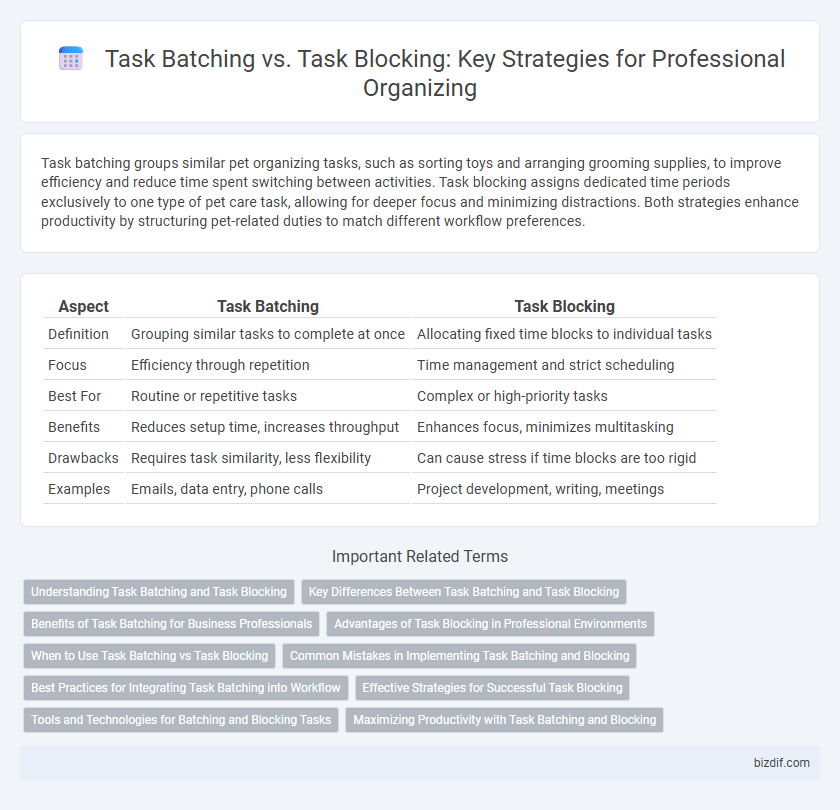Task batching groups similar pet organizing tasks, such as sorting toys and arranging grooming supplies, to improve efficiency and reduce time spent switching between activities. Task blocking assigns dedicated time periods exclusively to one type of pet care task, allowing for deeper focus and minimizing distractions. Both strategies enhance productivity by structuring pet-related duties to match different workflow preferences.
Table of Comparison
| Aspect | Task Batching | Task Blocking |
|---|---|---|
| Definition | Grouping similar tasks to complete at once | Allocating fixed time blocks to individual tasks |
| Focus | Efficiency through repetition | Time management and strict scheduling |
| Best For | Routine or repetitive tasks | Complex or high-priority tasks |
| Benefits | Reduces setup time, increases throughput | Enhances focus, minimizes multitasking |
| Drawbacks | Requires task similarity, less flexibility | Can cause stress if time blocks are too rigid |
| Examples | Emails, data entry, phone calls | Project development, writing, meetings |
Understanding Task Batching and Task Blocking
Task batching involves grouping similar tasks together to complete them more efficiently by minimizing context switching, such as answering all emails at once or making consecutive phone calls. Task blocking allocates dedicated time slots exclusively for one specific task or type of work, enhancing focus and reducing distractions during that period. Understanding the differences between task batching and task blocking helps professionals optimize productivity by aligning their workflow with personal concentration patterns and task requirements.
Key Differences Between Task Batching and Task Blocking
Task batching groups similar tasks to be completed together, enhancing efficiency by minimizing context switching, while task blocking allocates specific time slots to individual tasks, promoting focused attention on one activity at a time. Task batching is ideal for repetitive, low-complexity tasks like email management or data entry, whereas task blocking benefits complex projects requiring deep concentration, such as strategic planning or creative work. Both methods improve productivity, but choosing between them depends on task nature and personal workflow preferences.
Benefits of Task Batching for Business Professionals
Task batching enhances productivity for business professionals by grouping similar tasks, reducing mental fatigue and minimizing context switching. This method streamlines workflow, leading to better time management and increased efficiency throughout the workday. Implementing task batching can result in higher output quality and improved focus on critical business objectives.
Advantages of Task Blocking in Professional Environments
Task blocking enhances productivity in professional environments by allocating dedicated time slots for specific tasks, minimizing context switching and reducing cognitive load. This method fosters deeper focus and efficiency, enabling professionals to complete complex or high-priority assignments with fewer interruptions. Implementing task blocking leads to improved time management and a clearer work structure, which supports goal achievement and minimizes burnout.
When to Use Task Batching vs Task Blocking
Task batching is ideal for handling repetitive tasks that require similar tools or mental states, such as responding to emails or data entry, as it minimizes context switching and boosts efficiency. Task blocking suits complex projects demanding deep focus and uninterrupted time, like strategic planning or creative work, by allocating dedicated time periods without distractions. Choose task batching for quick, routine actions and task blocking when working on tasks that benefit from sustained concentration.
Common Mistakes in Implementing Task Batching and Blocking
Common mistakes in implementing task batching include grouping unrelated tasks, which reduces efficiency and increases cognitive load. In task blocking, failing to allocate sufficient time for breaks can lead to burnout and diminished focus. Overlooking task prioritization and flexibility within both methods often results in rigid schedules that hinder productivity.
Best Practices for Integrating Task Batching into Workflow
Task batching improves workflow efficiency by grouping similar tasks to minimize context switching and reduce cognitive load. Best practices include identifying repetitive tasks, setting specific time blocks for each batch, and using tools to track progress and deadlines. Integrating task batching with calendar management and prioritization frameworks enhances focus and productivity in professional organizing.
Effective Strategies for Successful Task Blocking
Task blocking is a highly effective strategy for professional organizing by allocating specific time slots for related tasks, which minimizes cognitive switching and enhances concentration. This technique leverages calendar segmentation to ensure deep work periods, increasing productivity and reducing procrastination compared to task batching's grouping approach. Implementing focused intervals using tools like the Pomodoro Technique further optimizes task blocking, driving successful project completion and efficient time management.
Tools and Technologies for Batching and Blocking Tasks
Task batching utilizes digital tools like Trello, Asana, and ClickUp to group similar tasks, leveraging features such as labels, deadlines, and custom boards for enhanced focus and efficiency. Task blocking benefits from calendar apps like Google Calendar, Microsoft Outlook, and time-tracking tools like Toggl, allowing precise allocation of dedicated time slots for uninterrupted work periods. Combining these technologies enhances professional organizing by minimizing context switching and optimizing productivity workflows.
Maximizing Productivity with Task Batching and Blocking
Task batching groups similar tasks together to reduce cognitive switching, increasing efficiency by allowing the brain to focus on one type of activity at a time. Task blocking allocates specific time periods for different activities, creating structured work sessions that minimize distractions and maintain sustained attention. Combining task batching with blocking optimizes productivity by leveraging focused work intervals and task similarity to enhance workflow and reduce mental fatigue.
Task batching vs Task blocking Infographic

 bizdif.com
bizdif.com